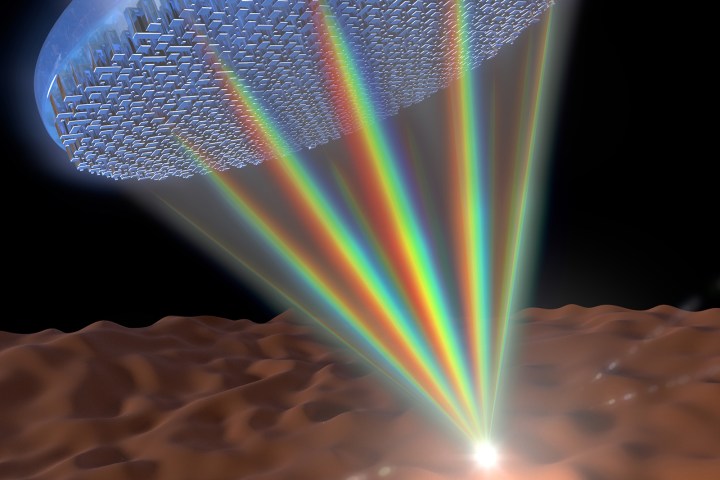
Each color in the visible spectrum has different qualities — which means if all those colors passed through a flat sheet of glass, they wouldn’t reach the camera sensor at the same time, creating a colored distortion called chromatic aberration. Traditional glass lenses solve this problem by curving the glass so that each color of light reaches the destination at the same exact time.
Flat lenses or metalenses use tiny structures instead of a curve to focus the light. While previous research successfully focused some light with this type of lens, the flat lenses weren’t capable of focusing all the visible colors. Earlier efforts expanded the single wavelength capability of flat lenses to capture blues and greens, but not the full visible specturm.
So how did the researchers give flat lenses full-color capability? By adjusting those tiny structures that focus the light. Rather than single uniform structures across the lens, the research group used pairs of nanostructures. These pairs can control the speed of the light passing through, and by altering that speed, can help ensure all the colors reach the camera sensor at the same time. The nanostructures on the lens are made with titanium dioxide, a material most commonly used in products like paints and cosmetics.
“One of the biggest challenges in designing an achromatic broadband lens is making sure that the outgoing wavelengths from all the different points of the metalens arrive at the focal point at the same time,” said Wei Ting Chen, one of the paper’s authors and a SEAS postdoctoral fellow. “By combining two nanofins into one element, we can tune the speed of light in the nanostructured material, to ensure that all wavelengths in the visible are focused in the same spot, using a single metalens. This dramatically reduces thickness and design complexity compared to composite standard achromatic lenses.”
While the research is the latest in a long history of different studies, the group doesn’t plan on stopping with just the visible light. The group says that creating a larger metalens could have applications in virtual reality, already planning to focus their next research in that area.
Harvard says the technology has already been licensed to a company to develop commercial products, but did not go into further detail as to what type of consumer device the flat lens will first be integrated in.
The full research report is available from Nature Nanotechnology.



